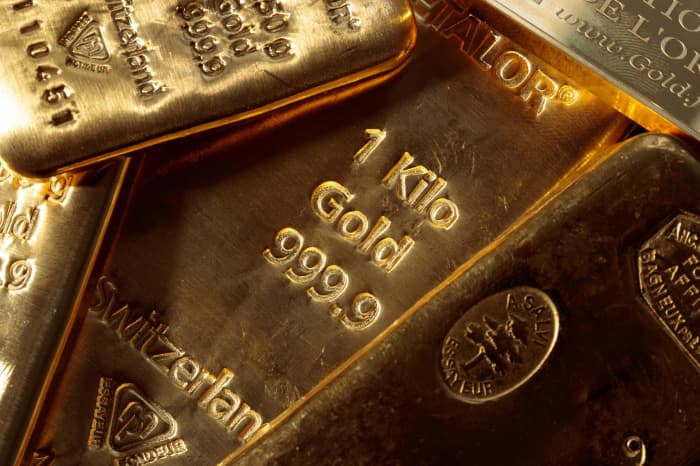Gold futures settled higher on Friday, as the U.S. dollar softened following the Bank of Japan’s decision to tweak its monetary policy framework, and as a measure of U.S. consumer prices that is closely monitored by the Federal Reserve showed that the pace of price increases slowed last month.
Price action
-
Gold for December delivery
GC00,
-0.21% GCZ23,-0.25% increased by $14.70, or 0.7%, to settle at $1,999.90 per ounce on Comex, with prices down nearly 0.3% for the week, according to Dow Jones Market Data. -
Silver futures for September delivery
SI00,
-0.24% SIU23,-0.24% gained 13 cents, or 0.5%, to end at $24.50 per ounce, posting a weekly decline of 1.5%. -
October platinum
PL00,
-0.24% PLV23,-0.24% dropped $1.30, or 0.1%, to finish at $943.70 per ounce, losing 2.9% for the week, while palladium for September delivery PA00,+0.11% PAU23,+0.11% gained by $3, or 0.2%, to settle at $1,239.60 per ounce and booked a weekly decline of 3.7%. -
Copper for September delivery
HG00,
-0.03% HGU23,-0.03% was up 5 cents, or 1.3%, settling at $3.93 per pound. For the week, the copper jumped 2.8%.
Market drivers
A stronger U.S. dollar and higher Treasury yields helped weigh on gold prices earlier in the week as the Federal Reserve and European Central Bank announced their latest interest-rate hikes.
But the yellow metal found some respite to finish the session higher on Friday as futures prices bounced off the $1,940-per-ounce level after the personal consumption expenditures price index showed U.S. inflation eased 0.2% in June, compared with May’s increase of 0.3%.
The rate of core inflation, which omits volatile food and energy prices, rose 4.1% in the last 12 months, down sharply from May’s 4.6% increase, but that still puts it at a more than two-year low. It’s still far above the Fed’s 2% target, however.
In other U.S. economic news, consumer spending rose 0.5% in June in a sign of confidence in the economy as inflation eased again and the U.S. economy continued to grow.
Earlier, the Bank of Japan said it would loosen its grip on yields of Japanese government bonds, a decision that sent shock waves through international bond markets and pushed the yield on the 10-year JGB
TMBMKJP-10Y,
The yield on the 10-year JGB rose 54 basis points to 0.545%, its highest level since September 2014.
The U.S. dollar was trading lower, with the ICE U.S. Dollar Index
DXY,
See: What’s next for markets after the Bank of Japan enacts policy tweak
Analysts took gold’s latest move higher as a sign that prices could climb further, although expectations for higher international bond yields could also put a damper on the price of the yellow metal.
“From a technical standpoint, gold has slightly rebounded from yesterday’s low at $1,940, which is now considered the first support zone, and this represents a positive signal,” said Rupert Rowling, a market analyst at Kinesis Money, in emailed commentary.
“The closing of the gold price this evening will be crucial in determining whether the markets have fully absorbed the macroeconomic news from yesterday,” he said.








